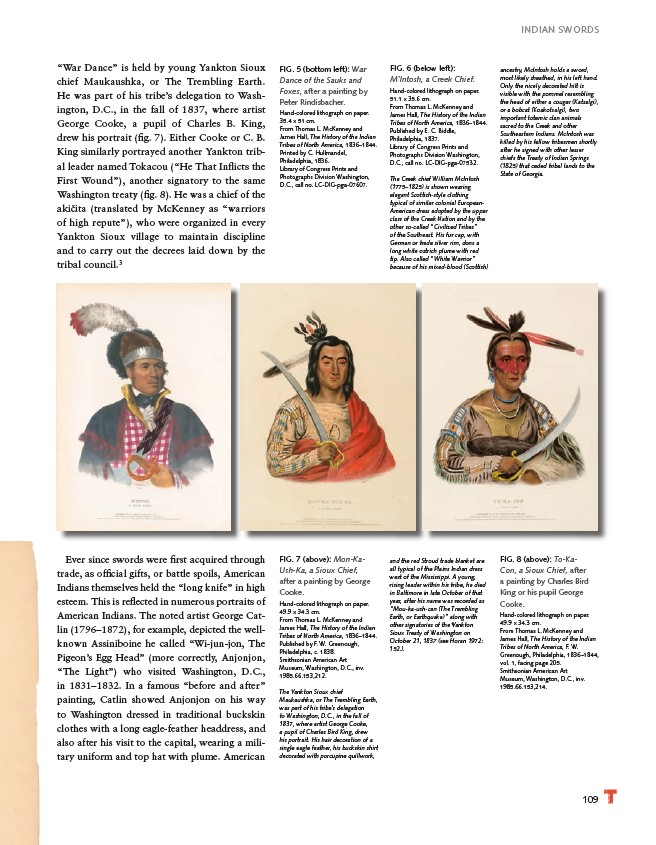
109
FIG. 5 (bottom left): War
Dance of the Sauks and
Foxes, after a painting by
Peter Rindisbacher.
Hand-colored lithograph on paper.
35.4 x 51 cm.
From Thomas L. McKenney and
James Hall, The History of the Indian
Tribes of North America, 1836–1844.
Printed by C. Hullmandel,
Philadelphia, 1836.
Library of Congress Prints and
Photographs Division Washington,
D.C., call no. LC-DIG-pga-07607.
FIG. 6 (below left):
M’Intosh, a Creek Chief.
Hand-colored lithograph on paper.
51.1 x 35.6 cm.
From Thomas L. McKenney and
James Hall, The History of the Indian
Tribes of North America, 1836–1844.
Published by E. C. Biddle,
Philadelphia, 1837.
Library of Congress Prints and
Photographs Division Washington,
D.C., call no. LC-DIG-pga-07532.
The Creek chief William McIntosh
(1775–1825) is shown wearing
elegant Scottish-style clothing
typical of similar colonial European-
American dress adopted by the upper
class of the Creek Nation and by the
other so-called “Civilized Tribes”
of the Southeast. His fur cap, with
German or trade silver rim, dons a
long white ostrich plume with red
tip. Also called “White Warrior”
because of his mixed-blood (Scottish)
ancestry, McIntosh holds a sword,
most likely sheathed, in his left hand.
Only the nicely decorated hilt is
visible with the pommel resembling
the head of either a cougar (Katsalgi),
or a bobcat (Koakotsalgi), two
important totemic clan animals
sacred to the Creek and other
Southeastern Indians. McIntosh was
killed by his fellow tribesmen shortly
after he signed with other lesser
chiefs the Treaty of Indian Springs
(1825) that ceded tribal lands to the
State of Georgia.
FIG. 7 (above): Mon-Ka-
Ush-Ka, a Sioux Chief,
after a painting by George
Cooke.
Hand-colored lithograph on paper.
49.9 x 34.3 cm.
From Thomas L. McKenney and
James Hall, The History of the Indian
Tribes of North America, 1836–1844.
Published by F. W. Greenough,
Philadelphia, c. 1838.
Smithsonian American Art
Museum, Washington, D.C., inv.
1985.66.153,212.
The Yankton Sioux chief
Maukaushka, or The Trembling Earth,
was part of his tribe’s delegation
to Washington, D.C., in the fall of
1837, where artist George Cooke,
a pupil of Charles Bird King, drew
his portrait. His hair decoration of a
single eagle feather, his buckskin shirt
decorated with porcupine quillwork,
and the red Stroud trade blanket are
all typical of the Plains Indian dress
west of the Mississippi. A young,
rising leader within his tribe, he died
in Baltimore in late October of that
year, after his name was recorded as
“Mou-ka-ush-can (The Trembling
Earth, or Earthquake)” along with
other signatories of the Yankton
Sioux Treaty of Washington on
October 21, 1837 (see Horan 1972:
152.).
FIG. 8 (above): To-Ka-
Con, a Sioux Chief, after
a painting by Charles Bird
King or his pupil George
Cooke.
Hand-colored lithograph on paper.
49.9 x 34.3 cm.
From Thomas L. McKenney and
James Hall, The History of the Indian
Tribes of North America, F. W.
Greenough, Philadelphia, 1836–1844,
vol. 1, facing page 205.
Smithsonian American Art
Museum, Washington, D.C., inv.
1985.66.153,214.
“War Dance” is held by young Yankton Sioux
chief Maukaushka, or The Trembling Earth.
He was part of his tribe’s delegation to Washington,
D.C., in the fall of 1837, where artist
George Cooke, a pupil of Charles B. King,
drew his portrait (fi g. 7). Either Cooke or C. B.
King similarly portrayed another Yankton tribal
leader named Tokacou (“He That Infl icts the
First Wound”), another signatory to the same
Washington treaty (fi g. 8). He was a chief of the
akicita (translated by McKenney as “warriors
of high repute”), who were organized in every
Yankton Sioux village to maintain discipline
and to carry out the decrees laid down by the
tribal council.3
Ever since swords were fi rst acquired through
trade, as offi cial gifts, or battle spoils, American
Indians themselves held the “long knife” in high
esteem. This is refl ected in numerous portraits of
American Indians. The noted artist George Catlin
(1796–1872), for example, depicted the wellknown
Assiniboine he called “Wi-jun-jon, The
Pigeon’s Egg Head” (more correctly, Anjonjon,
“The Light”) who visited Washington, D.C.,
in 1831–1832. In a famous “before and after”
painting, Catlin showed Anjonjon on his way
to Washington dressed in traditional buckskin
clothes with a long eagle-feather headdress, and
also after his visit to the capital, wearing a military
uniform and top hat with plume. American
INDIAN SWORDS